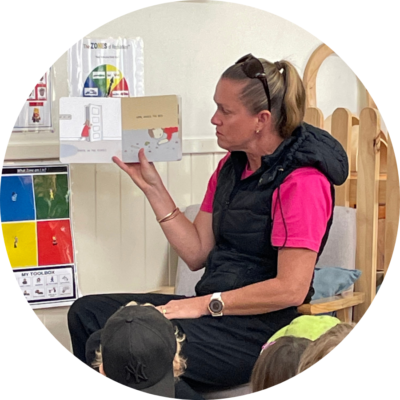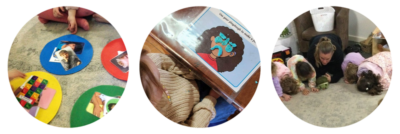In this School Spotlight, we are highlighting the exceptional work of Inverell District Family Services (IDFS) led by Cammy Alliston, an Inclusion Support Teacher and Early Education Teacher. Cammy’s crucial role in the organization is to support children with additional needs through securing funding, supporting educators with resources and strategies, directly teaching programs (such as The Zones of Regulation), and providing families access to services for their children.
About The Inverell Community in Australia
Inverell is a rural farming community of approximately 12,000 people in the North West of NSW in Australia. The community-based IDFS organization operates four preschools, three daycares, and two vans that travel to rural remote areas to deliver a mobile preschool program. Beyond that, they offer home daycare, playgroups, and a toy library. Inverell is a multicultural community with a significant indigenous population and diverse socioeconomic backgrounds. Inverell District Family Services is the primary provider of childcare and early education in the area, dedicated to delivering quality, inclusive early education for learners from all walks of life.
Impact of the Covid-19 Pandemic on Social and Emotional Learning (SEL)
Since the Covid-19 pandemic, the staff at IDFS had seen an increase in children presenting with additional needs, ranging from speech to anxiety and behavioral issues. Recognizing the need to support both children and educators in managing these challenges, the organization turned to The Zones of Regulation. Their goal was to provide everyone with strategies and resources to assist them in the transition back into preschool. While direct teaching was provided to the children, the program also aimed to upskill educators and demonstrate how to implement The Zones into their services.
Planning and Implementing The Zones of Regulation

Ms. Alliston and her team were fortunate to receive a grant from the NSW Department of Education, which provided them with the time to develop and adapt the original Zones of Regulation Curriculum (2011) for their preschool program. This included purchasing curriculum materials, supplementary resources, regulation tools, and related literacy supplies. They attended web-based Zones of Regulation Trainings, and consulted with community experts and educators on what they needed to get started.
Follow the link to their video to see The Zones in action! Inverell District Family Services VIDEO
The 10-week program was piloted at one of their preschools, focusing on children preparing formal schooling (Pre-K). In each lesson, they introduced the Zones of Regulation concepts and ideas weekly along with “Charlie the Chameleon,” a storybook character who changes colors as his feelings change. Educators then modeled and reinforced the language and ideas presented throughout the rest of the week. They later expanded the program to all preschools and daycare services within the organization, and they are now in their third year of delivering it. Their goal is to fully embed the program across all services and collaborate with primary schools so that it follows children beyond preschool.
Classroom Vignette: A Teacher’s Account
Early into piloting the program a child came into the classroom from outside, clearly upset and angry. When asked if everything was ok, he replied “no.” When asked if he could show me how he was feeling on the Zones [Check-In], he pointed to the Red Zone, expressing that he was angry and then explained what had happened outside. When asked what he needed, he said he would like to sit in the “Comfortable Corner” for a little while and play with some of the tools there. A few minutes later he said he was ready to go back outside. I gave him a hug and he was off playing happily. It was this experience which quickly proved to me that this program worked and that the ideas, strategies, and tools were going to be so beneficial to the children.

Connecting SEL with Families and Caregivers
Ms. Alliston and the program staff prioritized connecting with families and caregivers through different methods, starting with an introduction letter to explain what The Zones of Regulation program is and how and why we were implementing it. Engaging in conversations with caregivers allowed them to address questions about how their children were doing. They also provided copies of Zones visuals and extended information to encourage caregivers to bridge the concepts and conversations to home and build consistency. Ms. Alliston reports, “The Zones has created an opportunity for parents to connect with their children and understand how their children are feeling. It has allowed for parents to communicate their own feelings as well as providing strategies and tools to support through this time. We have had engagement with a lot of parents who are now implementing the program at home and this is supporting the whole family.”
“The Zones has created an opportunity for parents to connect with their children and understand how their children are feeling. It has allowed for parents to communicate their own feelings as well as providing strategies and tools to support through this time. We have had engagement with a lot of parents who are now implementing the program at home and this is supporting the whole family.” -Cammy Alliston
Outcomes of Using The Zones in their Community
Here is how Ms. Alliston describes the impact using The Zones of Regulation has had within their learning community:
Implementing The Zones within our services has not only allowed children to recognise, explore and understand their emotions, it has also allowed educators to better understand the impact emotions have on children and the importance of acknowledging them and supporting regulation. The staff are more confident in talking about and addressing emotional issues with the children. It has allowed for better communication, greater understanding and often a quicker resolution to addressing the children’s emotional needs.
The children are excellent at recognising what Zone they are in and their vocabulary around emotions has significantly increased. They are able to access tools and strategies that they know will help and they are moving from co-regulation to self-regulation. I feel they are better at understanding the emotions of others and I feel this has built up tolerance and acceptance of others. Our community has seen that when children are emotionally regulated they learn and play better.
Want to learn more about implementing The Zones of Regulation at school? Visit our For Your School Page!





